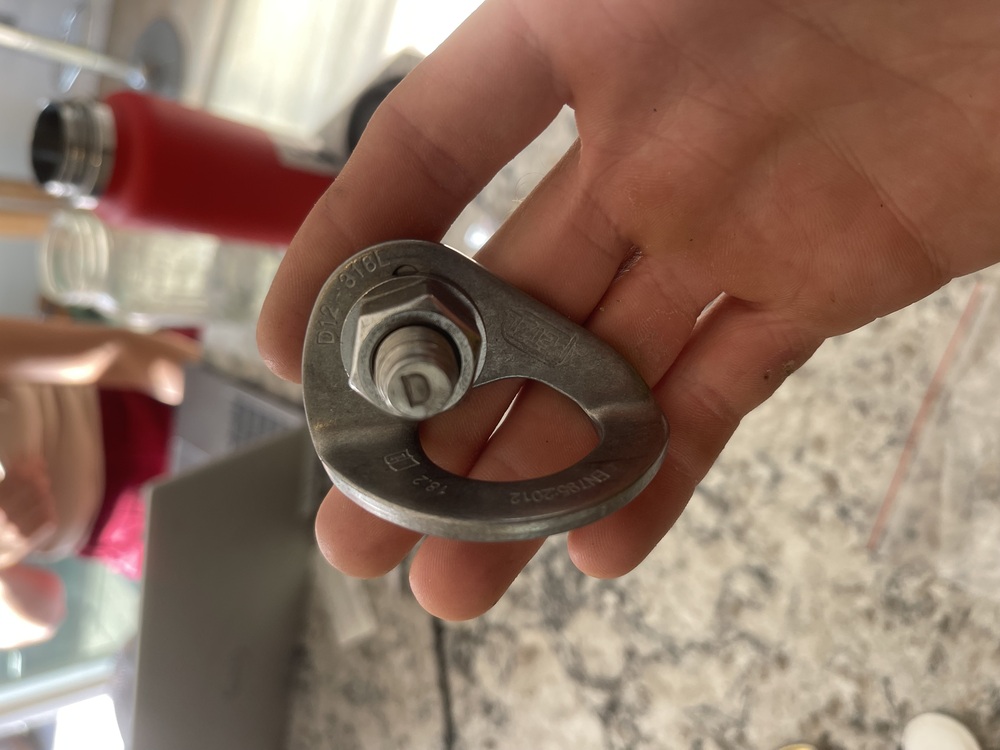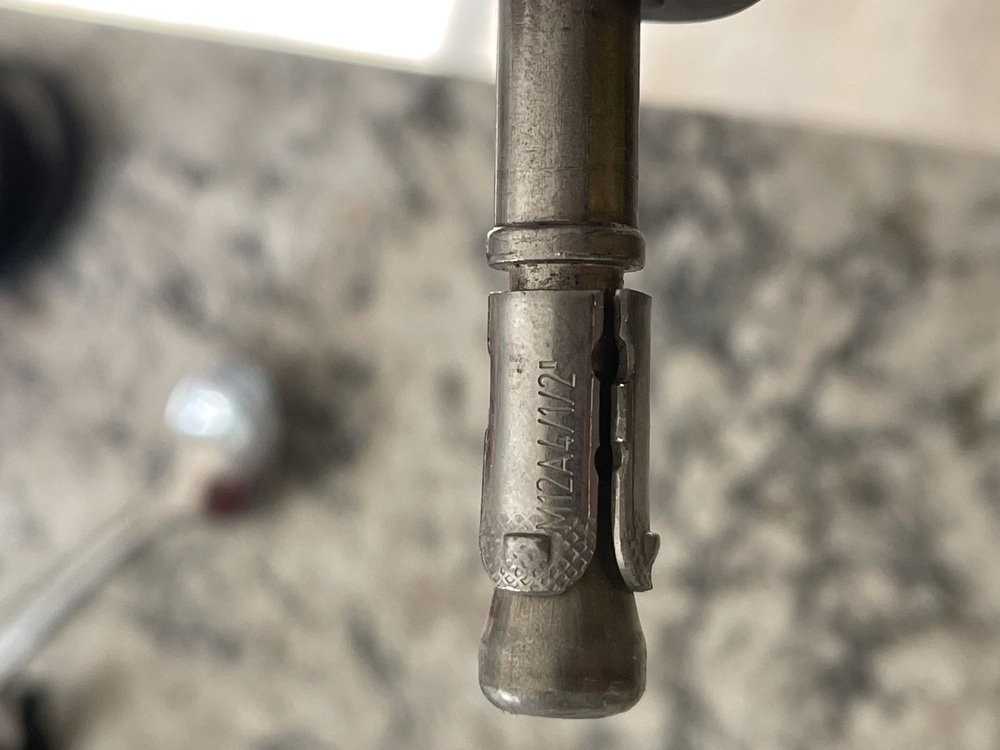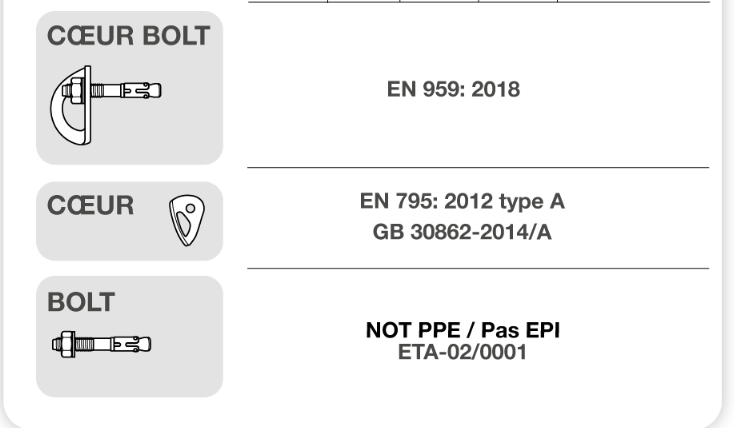Need help finding torque specs and how deep to drill info. (Petzl bolts)
|
|
I was gifted some petzl bolts and need to know placement specs and torque info. I know they work with 1/2 inch bits, that’s all I know. M12A L/1/22 bolt with d12-316L hangars. |
|
|
I don't know the torque spec (probably around 25-30 ft pounds), but as to how deep, because it is a wedge bolt, you should drill about an inch deeper than the length of the bolt. That way the bolt can be "disappeared" by punching it in, for replacement or if you decide it needs to be moved after initially equipping the route. |
|
|
Erroneous Publicus wrote: ok cool. So I can't drill a hole thats too deep? i've only replaced these kinds of bolts. |
|
|
I thought you need a 12mm bit for these? |
|
|
Torque specs aren’t crucial, if using an open ended wrench and tightening by hand just crank down on it till it becomes difficult to turn. Specific specs can only be known if you know the manufacturer of the bolt. The hanger is Petzl but is the bolt also? |
|
|
I've been using those with 12mm bits. I'm sure they *should* work with 1/2 inch (12.7mm). Best to see what Petzl says. https://www.petzl.com/US/en/Professional/Anchors/COEUR-BOLT-STAINLESS |
|
|
Definitely use a 12mm drill bit, not 1/2" (12.7mm) Since it's 4.5" bolt, you should drill at least 4.5" deep, or a little deeper to disappear the bolt if the need ever arises. Drilling deeper is not really a risk Edit: I was assuming the stamp on the clip (4/1/2") is the bolt length but I guess it's not, as stated below "D" means the bolt is between 3-3.5" |
|
|
That looks like it might be made by Hilti. 316 stainless. I'd torque it to 25 ft lbs. |
|
|
Torque it about as tight as you can with a 6" wrench... assuming you're not a power lifter :) and check back to tighten it again in a week or 2 |
|
|
More important than knowing the torque is knowing the correct diameter. DO NOT use a 1/2 bit for a 12 mm bolt. The hole will be too big. The easiest way to figure out the diameter is by trying a 12mm versus 1/2" nut on the bolt to see which one fits. Depth: The "D" on the end of the bolt means 3". "E" is 3 3/4 -- 4", "H" is 5", etc... |
|
|
I think that's a Petzl "Bolt" bolt. Yes, somehow that's the real name. There's not much info on it; it basically seems like a construction bolt. All of their 12mm bolts list 37 ft lbs for the torque, but it really doesn't matter for wedge bolts. The pattern on the clip matches a few places online: https://www.bergfreunde.eu/petzl-anker-bolt-stainless-bolt/ Ebay listing |
|
|
thank you! |
|
|
It's a weirdly unpopular opinion, but I think torque specs matter. They aren't that hard to get right and a torque wrench is a pretty cheap and easy tool to use. They're also not prohibitively heavy if you're not bolting deep in the backcountry. We should take pride in the changes we're privileged to make to public resources and strive for the highest level of craftsmanship possible when doing so. Additionally and in a similar vein, punching a wedge bolt back into the hole and patching it is an antiquated method for replacement that should be left in the past. Overdrill the hole if that makes you happy, but learn to remove it the right way so you don't put another hole in the rock when you have to replace it. |
|
|
It is odd that the bolt is stamped 12/1/2. Some of the bits I have been buying from Team Tough are marked for S.A.E and Metric. There is quite a bit of difference between 10mm and 3/8". Even more between 12mm and 1/2" i have questions |
|
|
Under torquing won’t cause catastrophic failure but can cause the bolt to become loose. Overtorquing can literally fracture the rock around the bolt in a cone pattern with the wide part being the surface of the rock. Or shear the bolt if it’s really strong rock. I have an old published guide that specifies 30 ft-lbs of torque for southeast sandstone. The bolt diameter affects this. I second the use of a torque wrench, but using a standard box wrench and cranking on it hard will get the job done, typically resulting in torques under manufacturing specifications |
|
|
Max Tepfer wrote: I agree with you mostly, other than with respect to overdrilling wedge bolts. If you are bolting ground up on overhanging terrain, your options for positioning bolts are limited. Once you've had the chance to actually climb the pitch, you may decide that one or more of the bolts that got you up the pitch initially need moving. Some might say "use a removable bolt" but having done that previously, they don't really provide any benefit over simply punching in the stud and patching the hole (aside from saving a few bucks). Replacing bolts on an established route is a different story. |
|
|
Max Tepfer wrote: Care to expand on the why you think it matters? |
|
|
Erroneous Publicus wrote: That makes sense. If you're planning to move the bolt anyway, then it's a moot point as a second hole is getting drilled regardless. My comment was more reacting to the unfortunately commonplace practice of rebolting by punching the old bolt in and putting a new one next to it. That's pretty lame. I think developers and rebolters alike should be held to the highest standards. Like you say there are for sure times that bolts need to be moved and planning on that eventuality makes good sense, but telling someone asking generally about bolt specs that a bolt can '...be disappeared for replacement...' is a bit different than saying that practice makes sense when doing a new route up overhanging rock ground up. That same sentiment about holding high standards is why I feel like we should be using torque wrenches to install machines that are technically called 'torque controlled expansion anchors.' (aka expansion bolts) Sure, it's fine 99.9% of the time and it's true that most bolts see very little load, (even regular loading at 6-7kn can be somewhat unusual) but some bolts get absolutely hammered and it can be difficult to predict what's going to happen every time. I've watched 3/8" diameter fixe glue ins deform to near the point of failure over the span of 10 years at Smith because they saw frequent high impact-force falls with next to no friction in the system. While it's probably fine, why not do the job right? It's really easy to use a torque wrench and they're not that bulky/heavy. Doing less compromises the integrity of the placement and, while that weakening might have enough margin most of the time, it won't always. Additionally, even when a bolt is loaded in shear, there's still some amount of tensile load as well. I know of two instances of wedge bolts failing in shear without breaking. (a normal lead fall on a bolt placed in vertical rock) In both cases, the whole stud came out intact. One failure I experienced personally (and ended up taking a 60 footer as a result) and the other happened at Smith a handful of years ago to someone else. I'm no engineer, but to me that indicates that if the expansion mechanism isn't operating to it's fullest ability, there's an increased potential for that particular mode of failure. If you don't torque it to spec, it's not operating at 100%. There's a whole other conversation to be had about the longevity of it staying at spec, but that doesn't seem like adequate justification to me to do a substandard job in the first place. |
|
|
Always use a torque wrench. While it is not as critical in a horizontal placement (sheer strength) because the bolt is unlikely to snap in a downward force. It is very critical if the bolt is placed in a vertical placement (tensile strength). If it is not properly torqued the wedge may not ride up on the cone and that little 1/2" wedge is what is holding the bolt in (tensile/pull-out strength).. I usually use sleeve bolts or glue-ins in vertical placements (roofs) for that reason. |
|
|
Here is a great article pointing to why using specified torque matters: https://www.structuremag.org/?p=11312 A summary of my take-away from the article along with other literature I've read on the subject: After installation of a wedge bolt, the clamping force (force of the clip against the surrounding stone) decreases over time due to compression within the stone and fractional movement within the anchor elements. Consequently, bolts can loose up to 50% of their clamping force in concrete. In stone, with all its imperfections, this loss may be higher. Under-torqued bolts could conceivably lose enough clamping force that they are no longer effective tensile anchors. Also note that the loss of clamping force also reduces anchor shear force since forces are no longer being effectively transferred to the surrounding rock. Over-torquing of bolts, on the otherhand, can cause fracturing of the surrounding stone, thus dramatically increasing the loss of clamping force. Over-torquing can also increase metal fatigue and distort anchor components, leading to failure, or, more commonly, stress fracturing and stress corrosion cracking. |
|
|
I do own a torque wrench, and noted! |

 Continue with onX Maps
Continue with onX Maps Sign in with Facebook
Sign in with Facebook




























